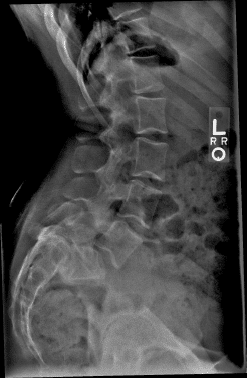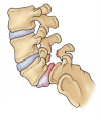
The pars interarticularis is a portion of the lumbar spine that joins the upper and lower joints together. The pars is normal in the majority of children.

Spondylolysis is a stress fracture in one of the vertebrae that make up the spinal column. It usually affects the fifth lumbar vertebra in the lower back or, much less commonly, the fourth lumbar vertebra.

Spondylolisthesis occurs if the stress fracture weak-ens the vertebrae so much that it is unable to main-tain its proper position and shifts forward out of place.

X-rays may discount several of the potential diagnoses and direct the physician to propose the diagnosis of a pars interarticularis stress injury or fracture.
There may be a hereditary aspect to spondylolysis. An individual may be born with thin vertebral bone and therefore may be vulnerable to this condition. Significant periods of rapid growth may encourage slippage.
Some sports, such as gymnastics, weight lifting, and football, put a great deal of stress on the bones in the lower back. They also require that the athlete constantly hyperextend the spine. However, all athletes with spondylol-ysis are at risk of developing low back pain.
The adolescent with lumbar back pain may have multiple reasons other than overuse or “growing pains” for the discomfort. (Table 1)
| Metabolic | Juvenile Osteoporosis |
| Inflammatory | Ankylosing Spondylitis sero-negative Arthritis |
| Neoplasm | Osteoid osteoma |
| Congenital | L5-S1 facet Hypoplasia |
| Developmental | Lumbar Scheurmann’s |
| Trauma | Pars Interarticularis stress fracture |
Each child is different, and your physician will suggest the best treatment option for the child. These include:
Continually observing a small stress fracture to check for progression as the child or adolescent grows.

Your orthopedist may recommend bracing to help stabilize the spine and allow the spondylolysis to heal. This light weight brace may be worn full time for up to 12 weeks. Physical therapy may follow bracing depending on each patients personal needs.
Surgery is performed in only the most severe cases. This may be needed if slippage progressively worsens or if back pain does not respond to non-surgical treatment and begins to interfere with activities of daily living. For spondylolisthesis, a spinal fusion is performed between the lumbar vertebra and the sacrum. This involves placing a system of screws and rods to stabilize the spine, and may involve a trans-laminar inter-body fusion as well. Spondylolysis surgery may be limited to actual repair of the fracture.